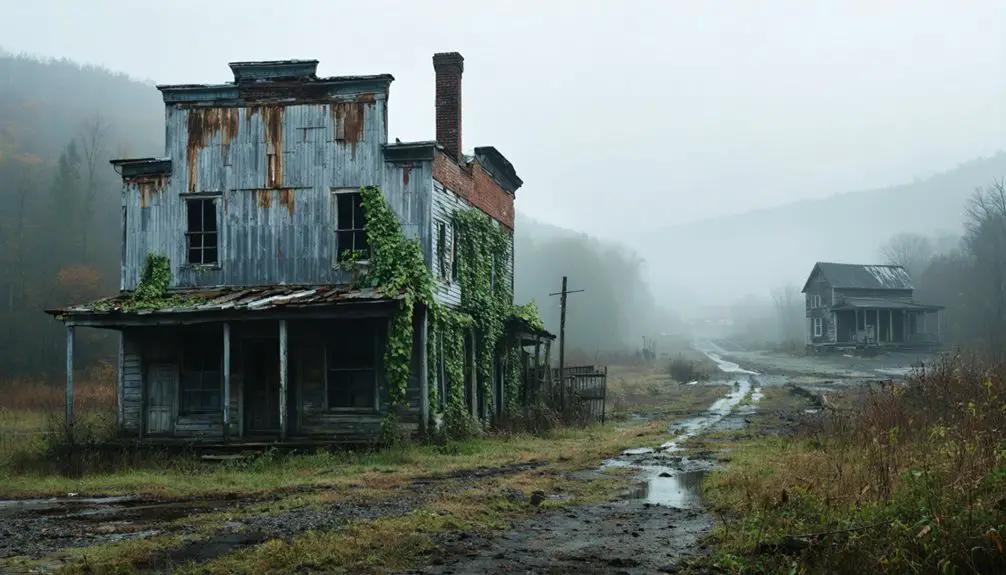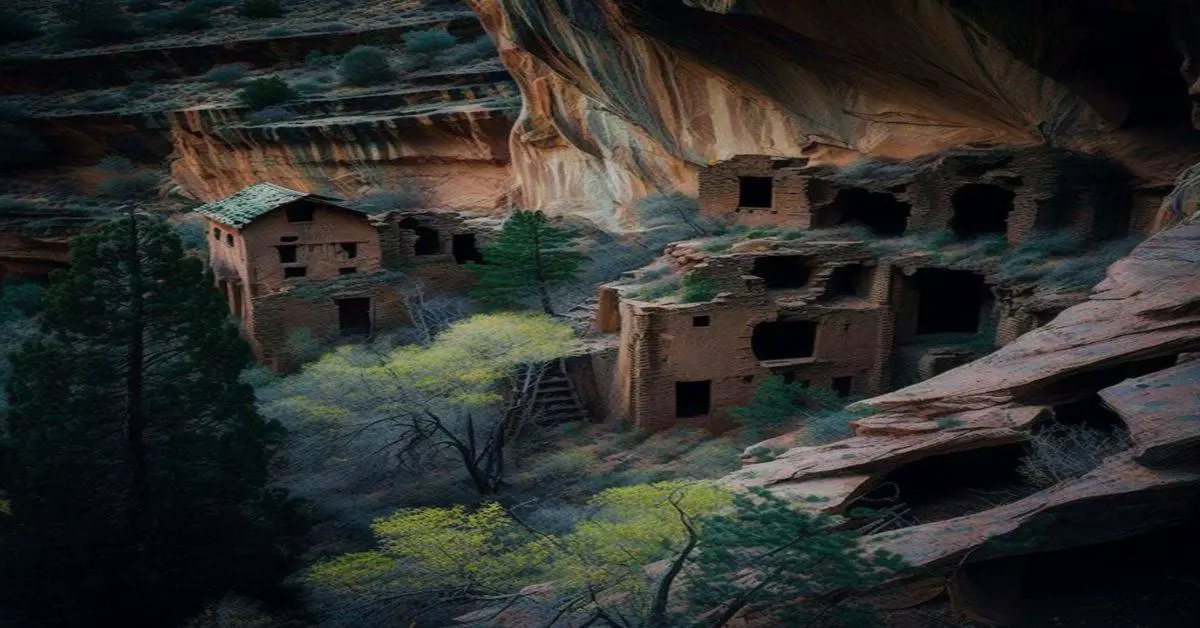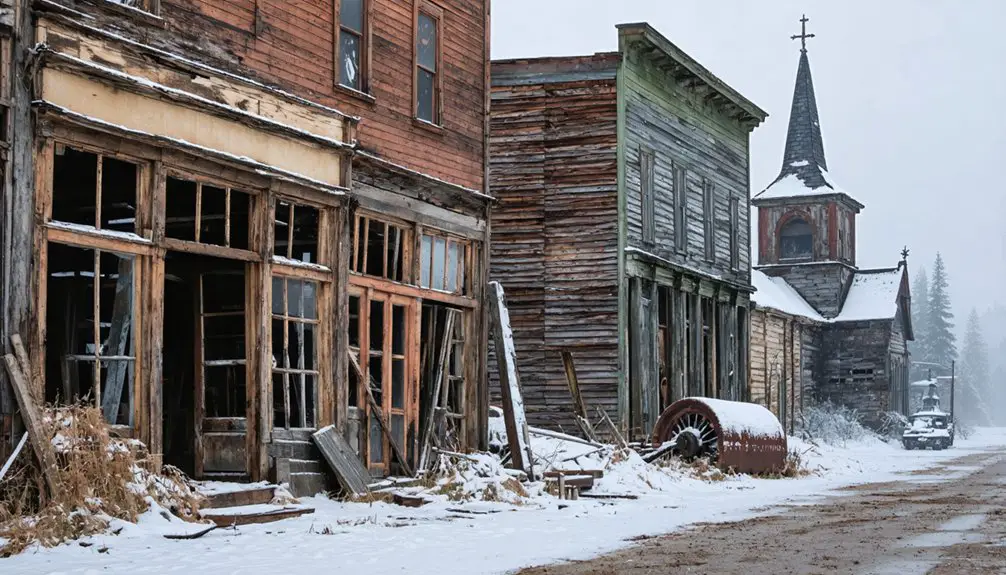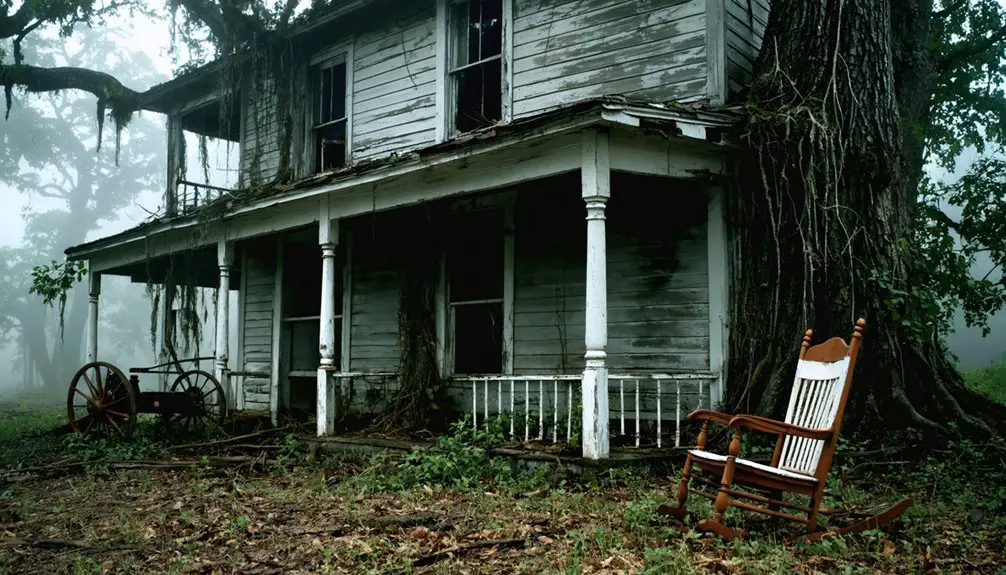You’ll find Caperton nestled along West Virginia’s New River, where it emerged as a thriving coal town in the 1880s. Founded by Joseph L. Beury and John Cooper, the town’s population peaked at 500 before declining sharply after 1900. Workers mined coal and operated 212 beehive coke ovens until the 1950s, when the community collapsed. Today, nature has reclaimed the site, but hidden beneath the dense Appalachian forest, Caperton’s industrial ruins tell a deeper story.
Key Takeaways
- Caperton was a coal mining town established in the 1880s beside the New River, named after founder George Caperton.
- The town operated West Virginia’s oldest coke ovens and reached a peak population of 500 residents in 1900.
- Economic dependence on coal led to decline when diesel locomotives reduced coal demand, halving the population by 1919.
- The town became completely abandoned between 1945-1954 after mine closures, losing its school and postal services.
- Nature has reclaimed the ghost town, though 212 beehive coke ovens and mine foundations remain as historical artifacts.
The Birth of a Coal Empire
While English explorer John Peter Salley first documented coal deposits near present-day Peytona in 1742, it wasn’t until the 1880s that Caperton emerged as an important coal and coke production center in the New River Gorge.
Though coal was known in the region since colonial times, Caperton’s industrial prominence arose nearly 140 years later in the 1880s.
You’ll find that coal magnates Joseph L. Beury and John Cooper strategically founded the town beside the New River, establishing a essential hub for both mining and coke production.
The region’s rich bituminous coal deposits attracted early industrialists, and by 1881, some of West Virginia’s oldest coke ovens were operating at Caperton.
You can still see evidence of this industrial heritage in the tall cut-stone foundations that dot the steep terrain, remnants of a time when Caperton played a significant role in feeding America’s growing steel and rail industries.
The site’s numerous beehive type coke ovens remain visible today, featuring distinctive stone arch facings with red brick construction behind them.
The town was named after George Caperton, one of the three original founders who helped establish this thriving coal community.
Life in the Company Town
If you’d lived in Caperton during its heyday, your daily routine would’ve revolved entirely around the coal company’s schedule, with the piercing whistle marking shift changes at the mines and coke ovens.
You’d have received your wages in coal scrip, redeemable only at the company store, binding your economic life to the coal company’s monopolistic control.
The social hierarchy was clearly visible in the town’s layout, from the owner’s hilltop mansion down to the workers’ boarding houses perched on stone foundations along the steep hillsides. Workers transported coal from the mines using monitor cars that ran between the headhouse and tipple. The town’s 212 coke ovens powered the industrial operations, producing fuel for steel manufacturing until demand declined in the early 1900s.
Daily Worker Routines
As the first rays of sunlight crept over the Appalachian hills, Caperton’s coal miners were already trudging toward the mine entrances for their grueling 10-12 hour shifts.
Your worker schedules revolved entirely around maximizing daylight hours, while your task responsibilities stretched from extracting coal by hand to managing the constantly burning beehive coke ovens.
- You’d spend hours loading heavy coal onto inclined tracks and aerial cable systems.
- You’d battle harsh winter conditions that made already dangerous work even riskier.
- You’d handle scorching hot coke production in perpetually operating ovens.
- You’d maintain essential equipment despite exhaustion from physical labor.
- You’d coordinate with others to keep coal moving onto C&O Railroad cars.
These demanding routines shaped every aspect of your daily existence in Caperton, from dawn until dusk.
Coal Scrip Economy
The iron grip of company-issued coal scrip dominated every financial aspect of your life in Caperton. You’d receive your wages in this company currency, forcing you to shop exclusively at the overpriced company store where scrip limitations prevented you from seeking better deals elsewhere.
Your housing, food, and basic necessities all depended on this controlled economy, where the company recaptured every bit of scrip you spent.
Living under this system meant you couldn’t save real cash or escape the cycle of debt. The company’s economic coercion kept you tied to Caperton through inflated store prices and direct rent deductions from your wages.
If you dared to protest working conditions or join union activities, they’d tighten their financial control even further, reminding you that your family’s survival depended on their scrip-based mercy.
Community Social Structure
Social life in Caperton revolved around three rigid hierarchies you’d instantly recognize: your job title in the mines, your race, and your relationship to company management.
The stark social stratification was evident in everything from housing assignments to which school your children attended. While mine managers enjoyed better accommodations, most miners lived in modest company-owned houses near the mines, fostering a type of forced community cohesion. At just 45 cents per ton, miners’ wages kept them economically dependent on the company and reinforced social divisions.
- Segregated facilities, including separate schools for white children until 1952
- Company-controlled housing determined by your position in the mines
- Social events and recreation strictly monitored by management
- Church and family gatherings served as rare spaces of independence
- Economic dependence on mining jobs reinforced social boundaries and company control
Working the Mines of Caperton
Mining operations in Caperton demanded innovative engineering solutions to extract coal from both sides of the New River and high into the surrounding hills.
New River Coal Company dominated the local mining landscape throughout its operations. You’d find a 1,460-foot inclined track carrying coal down the mountain’s north side, while an aerial cable system transported coal across the river from southern mines. These engineering feats connected directly to the Chesapeake and Ohio Railroad below.
You’d earn about $0.45 per ton working the mines, with strong miners pulling in $2.00 daily. The work wasn’t for the faint of heart – mining hazards were constant companions in the dark tunnels.
Coal extraction focused on valuable bituminous coal, prized for its low-smoke properties. The extracted coal fed 212 beehive ovens near town, transforming raw coal into valuable coke for steel production.
Peak Years and Prosperity
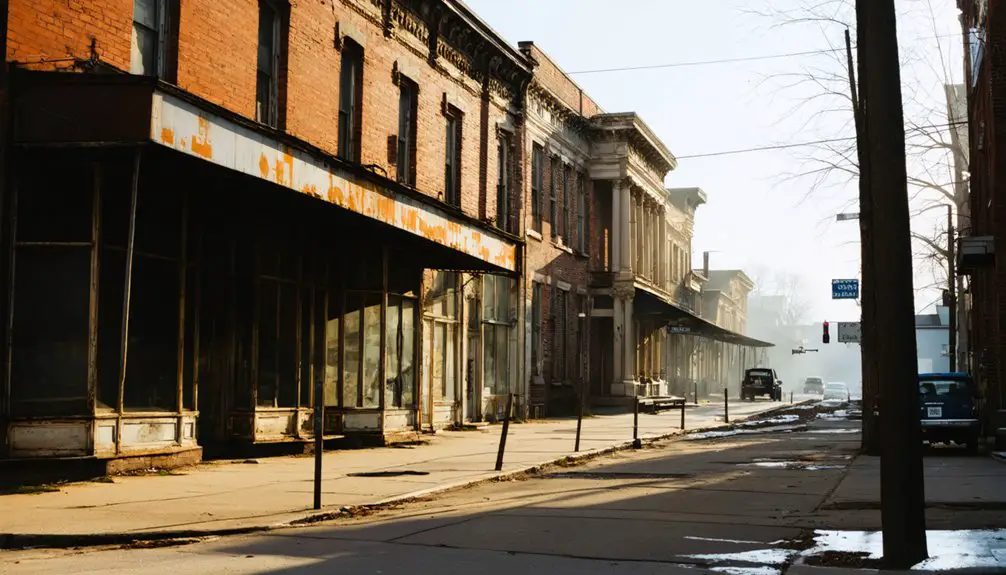
During its prime years from the 1880s through early 1900s, Caperton bustled with over 500 residents living among 100-plus structures that clung to the steep hillsides of New River Gorge.
You’d find yourself in a peak industry town where coal flowed down a 1,460-foot inclined track and across the river via aerial cables. The mining boom brought impressive engineering feats, with 212 beehive coke ovens processing coal into valuable industrial fuel. The discovery of smokeless coal in the region transformed the New River Gorge into a major industrial center.
- Tall cut-stone house foundations showcased the town’s permanent nature and prosperity
- A dedicated school and post office served the thriving community
- The C&O Railroad mainline connection enabled widespread market access
- Coal mining occurred simultaneously on both sides of the New River
- Victoria Coal & Coke Company’s operations dominated the early 1900s landscape
The Slow Decline of a Mining Community
As World War II came to a close, you’d have witnessed Caperton’s dramatic transformation from a bustling coal town into a community struggling to hold on, with its population plummeting from 500 to just 250 residents between 1900 and 1919.
The town’s dependency on coal proved devastating as diesel locomotives reduced demand, while the depletion of local coal reserves made continued mining operations increasingly unprofitable. This pattern continued well into later decades, as seen in McDowell County where coal jobs vanished rapidly after 1980.
Like many coal communities across West Virginia, Caperton’s decline reflected a broader pattern where out-of-state companies extracted wealth while leaving local populations economically vulnerable.
Post-War Population Exodus
While World War II brought economic prosperity to many American communities, Caperton, West Virginia experienced a steady population exodus that would ultimately seal its fate.
You’ll find that post-war mechanization drastically reduced labor needs in the mines, accelerating population shifts that had begun decades earlier. Migration trends show younger residents abandoning the town for urban opportunities, leaving behind an aging population that couldn’t sustain the community. The region’s rich coal deposits had once sustained the town’s growth, but could no longer support its future.
- The town’s population plummeted from 250 to nearly zero between 1945-1954
- Mine closures in the late 1940s triggered the final wave of departures
- The 1952 school closure forced families with children to relocate
- Loss of postal services in 1954 marked the end of official community status
- Surrounding counties with diverse economies remained stable while Caperton vanished
Economic Dependencies Unravel
Once Caperton hitched its fortunes entirely to coal and coke production in 1880, you’d find the seeds of its eventual downfall were already planted.
With 212 coke ovens and extensive mining infrastructure, the town lacked economic resilience beyond its single industry focus.
You’ll see how this dependency unraveled as coal markets shifted in the 1910s. When alternative energy sources emerged and industrial demand dropped, Caperton couldn’t adapt.
The town’s population, which had topped 500, plummeted by half by 1919. Various companies, from Victoria Coal & Coke to Sewell Colliery, cycled through ownership, but none could stem the decline.
Without community adaptation beyond mining, the closure of the school in 1952 and post office in 1954 marked the final chapter of Caperton’s story – a stark reminder of the risks of mono-industry dependence.
Nature Reclaims the Land

Since Caperton’s abandonment in the 1950s, nature has steadily transformed the former coal mining town into a living representation of ecological succession.
You’ll now find dense Appalachian forests thriving where buildings once stood, with oaks and maples pushing through old foundations. Wildlife regeneration has brought deer, birds, and small mammals back to their ancestral territories, while mosses and ferns blanket the scattered ruins.
- Beehive coke ovens, once industrial powerhouses, now serve as natural planters for climbing vines.
- Thick riverbank vegetation masks the remnants of mining operations.
- Native plant communities flourish where mining once compacted the soil.
- Stone foundations provide new homes for lichens and fungi.
- The New River’s waters run clearer, decades after pollution sources ceased.
Legacy of an Appalachian Ghost Town
As a demonstration to the boom-and-bust cycle of Appalachian coal towns, Caperton’s legacy endures through its scattered ruins and historical significance.
You’ll find evidence of historical resilience in the innovative solutions once employed here, from the 1,460-foot inclined track to the aerial cable system that conquered the challenging terrain.
The town’s cultural memory lives on through what remains of its 212 beehive coke ovens and mine foundations.
These remnants tell the story of a community that once supported 500 residents, powered by coal magnates like George H. Caperton and Joseph L. Beury.
Behind Caperton’s crumbling walls lies the legacy of 500 souls and the coal barons who shaped their destiny.
While the mines fell silent by the 1950s and the post office closed its doors in 1954, Caperton’s industrial heritage continues to captivate visitors, serving as a powerful reminder of Appalachia’s transformative coal era.
Frequently Asked Questions
What Happened to the Residents’ Personal Belongings When They Abandoned Caperton?
When you abandoned possessions during coal town closures, you’d take what you could carry, leaving resident memories behind as nature reclaimed homes and deteriorated whatever remained in the elements.
Are There Any Surviving Maps or Photographs of Caperton’s Original Layout?
Like scattered puzzle pieces of the past, you’ll find some 1870s photographs and early 1900s topographical maps, though historical preservation efforts haven’t yielded complete mapping techniques of the original town’s layout.
Did Any Descendants of Caperton’s Original Miners Remain in Nearby Communities?
You’ll find descendant stories in neighboring towns like Ansted, Nuttallburg, and Thurmond, where mining families maintained their community connections while adapting to new opportunities along the New River Gorge corridor.
What Were the Most Common Causes of Death in Caperton?
Like canaries in darkened shafts, miners faced death daily through devastating mining accidents, while black lung disease and violent outbreaks stalked the community. You’d likely succumb to workplace hazards or illness.
Were There Any Reported Paranormal Activities in the Abandoned Town Site?
You won’t find documented ghost sightings or haunted locations in this abandoned site. Unlike nearby Thurmond which has reported paranormal activity, there’s no verified evidence of supernatural occurrences here.
References
- https://kids.kiddle.co/List_of_ghost_towns_in_West_Virginia
- https://theclio.com/tour/1943
- https://www.latimes.com/archives/la-xpm-1989-04-23-tr-1673-story.html
- https://theclio.com/entry/136111
- https://coalcampusa.com/sowv/river/caperton/caperton.htm
- https://coalheritage.wv.gov/coal_history/Pages/Birth-of-the-Industry.aspx
- https://www.youtube.com/watch?v=3AnFBgeg7Tk
- https://kids.kiddle.co/Caperton
- https://wvhistoryonview.org/?f[date_sim][]=1876
- https://wvculture.org/wp-content/uploads/2021/03/William-gaston-caperton-house.pdf
